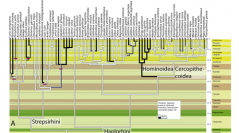

 Comptes Rendus Palevol
16 (1) - Pages 39-57
Comptes Rendus Palevol
16 (1) - Pages 39-57The evolutionary pressures leading to the appearance of the cecal appendix, its evolutionary relationships with the cecum, and the link between these gastrointestinal characters and ecology remain controversial. We collected data on appendix presence and size, other gastrointestinal characters, ecological variables, dietary habits, and social characters hypothesized to drive appendix evolution for 533 mammalian species. Using phylogeny-informed analyses, we identified the first evidence of a positive correlation between appendix presence and cecal apex thickness, and a correlation with cecal morphology, suggesting that the appendix and cecum may be evolving as a module, the cecoappendicular complex. A correlation between appendix presence and concentration of cecal lymphoid tissue supports the hypothesis of an adaptive immune function for this complex. Other new findings include an inverse correlation between relative cecum length and habitat breadth, and positive relationships between cecum length and mean group size, and between colon length and weaning age.
Adaptation, Appendicitis, Cecal appendix, Comparative methods, Gastrointestinal anatomy, Immune system, Evolutionary ecology